Explore 50 cities, interesting places, and unusual things to do in Middle East. Don't miss out on these must-see cities: Jerusalem, Petra, and Dubai.
Here is a compilation of the most breathtaking destinations you must explore.
Table of Contents
Western Wall, Jerusalem
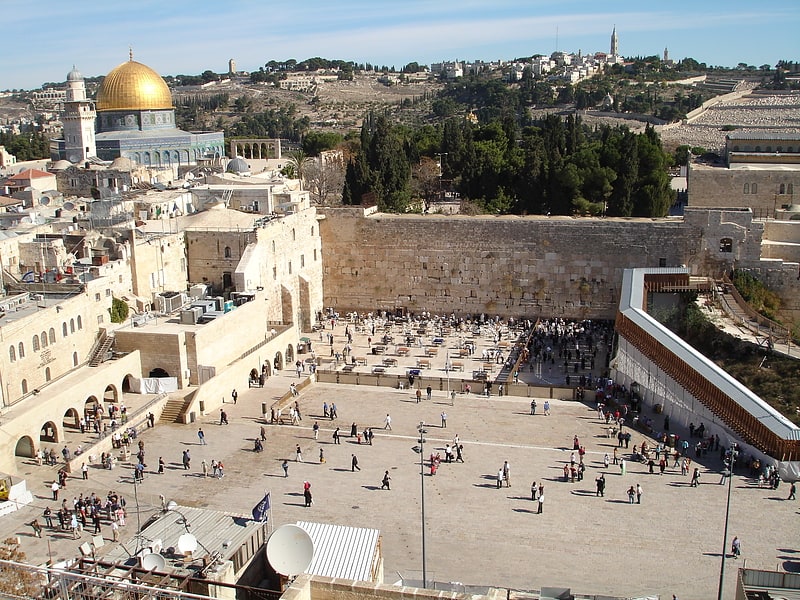
Also known as: הכותל המערבי
Ancient sacred site for Jewish prayer. The Wailing Wall or Western Wall, known in Islam as the Buraq Wall, is an ancient limestone wall in the Old City of Jerusalem. It is a relatively small segment of a far longer ancient retaining wall, known also in its entirety as the "Western Wall". The wall was originally erected as part of the expansion of the Second Jewish Temple begun by Herod the Great, which resulted in the encasement of the natural, steep hill known to Jews and Christians as the Temple Mount, in a huge rectangular structure topped by a flat platform, thus creating more space for the Temple itself, its auxiliary buildings, and crowds of worshipers and visitors.
In one of several varying Muslim traditions, it is the site where the Islamic Prophet Muhammad tied his winged steed, al-Buraq, on his Isra and Mi'raj to Jerusalem before ascending to paradise, and constitutes the western border of al-Haram al-Sharif, the Noble Sanctuary of the Al-Aqsa Mosque.
The Western Wall's holiness in Judaism is a result of its proximity to the Temple Mount. Because of the Temple Mount entry restrictions, the Wall is the holiest place where Jews are permitted to pray, though the site of the Holy of Holies, the most sacred site in the Jewish faith, lies behind it. The original, natural, and irregular-shaped Temple Mount was gradually extended to allow for an ever-larger Temple compound to be built at its top. This process was finalized by Herod, who enclosed the Mount with an almost rectangular set of retaining walls, made to support the Temple platform and using extensive substructures and earth fills to give the natural hill a geometrically regular shape. On top of this box-like structure, Herod built a vast paved platform that surrounded the Temple. Of the four retaining walls, the western one is considered closest to the former Holy of Holies, which makes it the most sacred site recognized by Judaism outside the previous Temple Mount platform.
Just over half the wall's total height, including its 17 courses located below street level, dates from the end of the Second Temple period, and is commonly believed to have been built by Herod the Great starting in 19 BCE, although recent excavations indicate that the work was not finished by the time Herod died in 4 BCE. The very large stone blocks of the lower courses are Herodian, the courses of medium-sized stones above them were added during the Umayyad period, while the small stones of the uppermost courses are of more recent date, especially from the Ottoman period.
The term Western Wall and its variations are mostly used in a narrow sense for the section traditionally used by Jews for prayer; it has also been called the "Wailing Wall", referring to the practice of Jews weeping at the site over the destruction of the Temples. During the period of Christian Roman rule over Jerusalem (ca. 324–638), Jews were completely barred from Jerusalem except on Tisha B'Av, the day of national mourning for the Temples, and on this day the Jews would weep at their holy places. The term "Wailing Wall" was thus almost exclusively used by Christians, and was revived in the period of non-Jewish control between the establishment of British Rule in 1920 and the Six-Day War in 1967. The term "Wailing Wall" is not used by religious Jews, and increasingly not by many others who consider it derogatory.
In a broader sense, "Western Wall" can refer to the entire 488-metre-long (1,601 ft) retaining wall on the western side of the Temple Mount. The classic portion now faces a large plaza in the Jewish Quarter, near the southwestern corner of the Temple Mount, while the rest of the wall is concealed behind structures in the Muslim Quarter, with the small exception of an 8-metre (26 ft) section, the so-called Little Western Wall. The segment of the western retaining wall traditionally used for Jewish liturgy, known as the "Western Wall" or "Wailing Wall", derives its particular importance to it having never been fully obscured by medieval buildings, and displaying much more of the original Herodian stonework than the "Little Western Wall". In religious terms, the "Little Western Wall" is presumed to be even closer to the Holy of Holies and thus to the "presence of God" (Shechina), and the underground Warren's Gate, which has been out of reach for Jews from the 12th century till its partial excavation in the 20th century, even more so.
Whilst the wall was considered Muslim property as an integral part of the Haram esh-Sharif and waqf property of the Moroccan Quarter, a right of Jewish prayer and pilgrimage existed as part of the Status Quo. This position was confirmed in a 1930 international commission during the British Mandate period.
The earliest source mentioning this specific site as a place of Jewish worship is from the 17th century. The previous sites used by Jews for mourning the destruction of the Temple, during periods when access to the city was prohibited to them, lay to the east, on the Mount of Olives and in the Kidron Valley below it. From the mid-19th century onwards, attempts to purchase rights to the wall and its immediate area were made by various Jews, but none was successful. With the rise of the Zionist movement in the early 20th century, the wall became a source of friction between the Jewish and Muslim communities, the latter being worried that the wall could be used to further Jewish claims to the Temple Mount and thus Jerusalem. During this period outbreaks of violence at the foot of the wall became commonplace, with a particularly deadly riot in 1929 in which 133 Jews and 116 Arabs were killed, with many more people injured. After the 1948 Arab–Israeli War the eastern portion of Jerusalem was occupied by Jordan. Under Jordanian control Jews were completely expelled from the Old City including the Jewish Quarter, and Jews were barred from entering the Old City for 19 years, effectively banning Jewish prayer at the site of the Western Wall. This period ended on June 10, 1967, when Israel gained control of the site following the Six-Day War. Three days after establishing control over the Western Wall site, the Moroccan Quarter was bulldozed by Israeli authorities to create space for what is now the Western Wall plaza.[1]
Address: Western Wall Plaza, 97500 Jerusalem
Yad Vashem, Jerusalem

Also known as: יד ושם
Holocaust memorial and education center. Yad Vashem is Israel's official memorial to the victims of the Holocaust. It is dedicated to preserving the memory of the Jews who were murdered; honoring Jews who fought against their Nazi oppressors and Gentiles who selflessly aided Jews in need; and researching the phenomenon of the Holocaust in particular and genocide in general, with the aim of avoiding such events in the future.
Established in 1953, Yad Vashem is located on the western slope of Mount Herzl, also known as the Mount of Remembrance, a height in western Jerusalem, 804 meters (2,638 ft) above sea level and adjacent to the Jerusalem Forest. The memorial consists of a 180-dunam (18.0 ha; 44.5-acre) complex containing two types of facilities: some dedicated to the scientific study of the Holocaust and genocide in general, and memorials and museums catering to the needs of the larger public. Among the former there are a research institute with archives, a library, a publishing house, and an educational center, and the International School for Holocaust Studies; among the latter, the Holocaust History Museum, memorial sites such as the Children's Memorial and the Hall of Remembrance, the Museum of Holocaust Art, sculptures, outdoor commemorative sites such as the Valley of the Communities, and a synagogue.
A core goal of Yad Vashem's founders was to recognize non-Jews who, at personal risk and without a financial or evangelistic motive, chose to save Jews from the ongoing genocide during the Holocaust. Those recognized by Israel as Righteous Among the Nations are honored in a section of Yad Vashem known as the Garden of the Righteous Among the Nations.
Yad Vashem is the second-most-visited Israeli tourist site, after the Western Wall, with approximately one million visitors each year. It charges no admission fee.[2]
Address: Har Hazikaron, P.O.B. 3477, 91034 שלם
Temple Mount, Jerusalem

Also known as: הר הבית
Hilltop compound of religious sites. The Temple Mount, known to Muslims as the Haram esh-Sharif and the Al-Aqsa Compound, is a hill in the Old City of Jerusalem that for thousands of years has been venerated as a holy site in Judaism, Christianity, and Islam alike.
The present site is a flat plaza surrounded by retaining walls (including the Western Wall) that was built during the reign of Herod the Great for an expansion of the temple. The plaza is dominated by three monumental structures from the early Umayyad period – the al-Aqsa Mosque, the Dome of the Rock and the Dome of the Chain – and four minarets. Herodian walls and gates, with additions from the late Byzantine and early Islamic periods, cut through the flanks of the Mount. Currently, it can be reached through eleven gates, ten reserved for Muslims and one for non-Muslims, with guard posts of Israeli police in the vicinity of each.
According to Jewish tradition and scripture, the First Temple was built by King Solomon, the son of King David, in 957 BCE, and was destroyed by the Neo-Babylonian Empire in 586 BCE; however, no substantial archaeological evidence has verified this. The Second Temple was constructed under the auspices of Zerubbabel in 516 BCE, and was destroyed by the Roman Empire in 70 CE. Orthodox Jewish tradition maintains it is here that the third and final Temple will be built when the Messiah comes. The Temple Mount is the holiest site in Judaism, and is the place Jews turn towards during prayer. Due to its extreme sanctity, many Jews will not walk on the Mount itself, to avoid unintentionally entering the area where the Holy of Holies stood, since according to rabbinical law, there is still some aspect of the divine presence at the site.
Among Muslims, the Mount is the site of one of the three Sacred Mosques, the holiest sites in Islam. Amongst Sunni Muslims, it is considered the third holiest site in Islam. Revered as the Noble Sanctuary, the location of Muhammad's journey to Jerusalem and ascension to heaven, the site is also associated with the Jewish biblical prophets who are also venerated in Islam. Umayyad Caliphs commissioned the construction of the al-Aqsa Mosque and Dome of the Rock on the site. The Dome was completed in 692 CE, making it one of the oldest extant Islamic structures in the world. The Al Aqsa Mosque rests on the far southern side of the Mount, facing Mecca. The Dome of the Rock currently sits in the middle, occupying or close to the area where the Holy Temple previously stood.
In light of the dual claims of Judaism and Islam, it is one of the most contested religious sites in the world. Since the Crusades, the Muslim community of Jerusalem has managed the site through the Jerusalem Islamic Waqf. The Temple Mount is within the Old City, which has been controlled by Israel since 1967. After the Six-Day War, Israel handed administration of the site back to the Waqf under Jordanian custodianship, while maintaining Israeli security control. It remains a major focal point of the Arab–Israeli conflict. In an attempt to keep the status quo, the Israeli government enforces a controversial ban on prayer by non-Muslims.[3]
Siq, Petra

Also known as: السيق
Narrow walkway through rock walls. The Siq is the main entrance to the ancient Nabatean city of Petra in southern Jordan. Also known as Siqit, it is a dim, narrow gorge and winds its way approximately 1.2 kilometres and ends at Petra's most elaborate ruin, Al Khazneh. A wide valley outside leading to the Siq is known as the Bab as-Sīq.[4]
Dubai Museum, Dubai

Also known as: متحف دبي
Museum in Dubai, United Arab Emirates. Dubai Museum is the main museum in Dubai, United Arab Emirates. It is located in the Al Fahidi Fort, built in 1787 and is the oldest existing building in Dubai.
The museum was opened by the Ruler of Dubai in 1971, with the aim of presenting the traditional way of life in the Emirate of Dubai. When entering, one can see the fort constructed and the various displays that go along with it. From the fort, there is a path to the galleries, which display the general culture of the land, especially in the 1800s. It includes local antiques as well as artifacts from African and Asian countries that traded with Dubai. It also includes several dioramas showing life in the emirate before the advent of oil, in addition to artifacts from recent discoveries as old as 3000 BC.
In 2007, Dubai Museum received 1,800 visitors daily, with a yearly total of 611,840. In March 2008, the museum had 80,000 visitors. The most popular times are from August to April. The museum received over 1 million visitors in 2013. The total area of Dubai museum is 4,000 square meters.[5]
Address: Al Fahidi St, Dubai (بر دبي)
Dubai Miracle Garden, Dubai
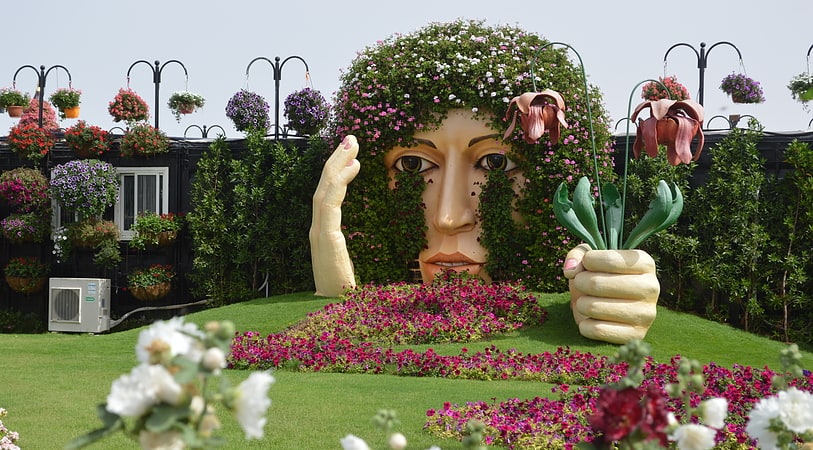
Also known as: حديقة دبي المعجزة
Garden in Dubai, United Arab Emirates. The Dubai Miracle Garden is a flower garden located in the district of Dubailand, Dubai, United Arab Emirates. The garden was launched on Valentine's Day in 2013. It occupies over 72,000 square metres, making it the world's largest natural flower garden, featuring over 50 million flowers and 250 million plants.
In April 2015, the garden was given the Moselle Award for New Garden Experiences of the year by the Garden Tourism Award 2015.[6]
Address: Dubai Land, Dubai
Burj Khalifa, Dubai

Also known as: برج خليفة
160-story skyscraper and observation deck. The Burj Khalifa, known as the Burj Dubai prior to its inauguration in 2010, is a skyscraper in Dubai, United Arab Emirates. With a total height of 829.8 m and a roof height of 828 m, the Burj Khalifa has been the tallest structure and building in the world since its topping out in 2009, supplanting Taipei 101, the previous holder of that status.
Construction of the Burj Khalifa began in 2004, with the exterior completed five years later in 2009. The primary structure is reinforced concrete and some of the structural steel for the building originated from the Palace of the Republic in East Berlin, the former East German parliament. The building was opened in 2010 as part of a new development called Downtown Dubai. It was designed to be the centrepiece of large-scale, mixed-use development. The decision to construct the building was based on the government's decision to diversify from an oil-based economy, and for Dubai to gain international recognition. The building is named in honour of the ruler of Abu Dhabi and president of the United Arab Emirates, Khalifa bin Zayed Al Nahyan; Abu Dhabi and the UAE government lent Dubai money to pay its debts. The building broke numerous height records, including its designation as the tallest building in the world.
Burj Khalifa was designed by a team led by Adrian Smith of Skidmore, Owings & Merrill, the firm that designed the Sears Tower in Chicago, a previous record holder for the world's tallest building. Hyder Consulting was chosen to be the supervising engineer with NORR Group Consultants International Limited chosen to supervise the architecture of the project. The design is derived from the Islamic architecture of the region, such as in the Great Mosque of Samarra. The Y-shaped tripartite floor geometry is designed to optimize residential and hotel space. A buttressed central core and wings are used to support the height of the building. Although this design was derived from Tower Palace III, the Burj Khalifa's central core houses all vertical transportation with the exception of egress stairs within each of the wings. The structure also features a cladding system which is designed to withstand Dubai's hot summer temperatures. It contains a total of 57 elevators and 8 escalators.
At a certain point in the architectural and engineering process, the original Emaar developers experienced financial problems, and required more money and economic funding. Sheikh Khalifa, the ruler of the United Arab Emirates, granted monetary aid and funding, hence the changing of the name to "Burj Khalifa". The concept of profitability derived from building high density developments and malls around the landmark has proven successful. Its surrounding malls, hotels and condominiums in Downtown Dubai have generated the most revenue from the project as a whole, while the Burj Khalifa itself made little or no profit.
Critical reception to Burj Khalifa has been generally positive, and the building has received many awards. However, there were numerous complaints concerning migrant workers from South Asia who were the primary building labour force. These centered on low wages and the practice of confiscating passports until duties were complete. Frequent suicides committed by expatriate employees who worked at the structure were reported in 2011.[7]
Address: Dubai, 1 Sheikh Mohammed bin Rashid Boulevard
Great Temple, Petra

Historical landmark in Jordan. The so-called Great Temple at Petra is a grand monumental complex that lies south of the Colonnaded Street at Petra. It covers an area of ~7,560 m2. The complex was probably completed in the early first century CE, under the rule of Nabataean king Aretas IV, as suggested by architectural and sculptural details.
The "Great Temple" occupied a prime spot in ancient Petra: from its ruins one can now see the Siq to the Southeast, the Qasr al-Bint to the West, and the Lower Market/Petra Pool Complex to the East. It is unclear whether the complex was a religious or administrative building, and – if it was indeed religious – how exactly it functioned or to what deity it was dedicated.[8]
Sheikh Zayed Mosque, Abu Dhabi
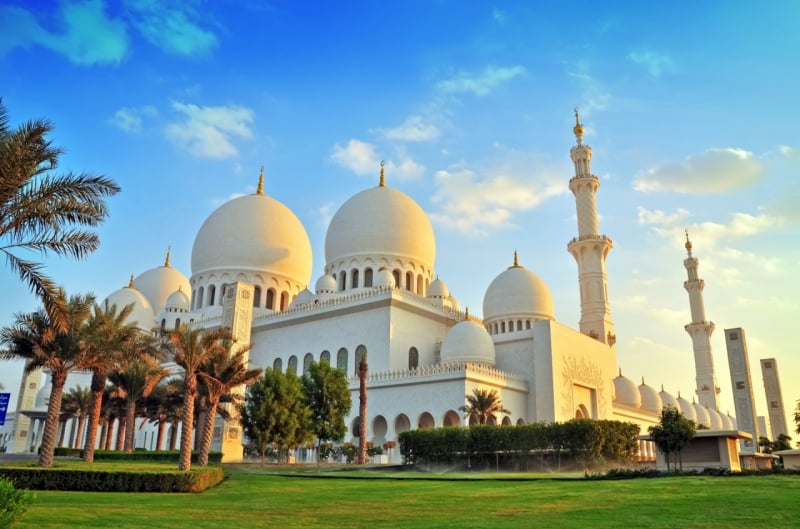
Also known as: جامع الشيخ زايد
Iconic landmark with 82 white domes. The Sheikh Zayed Grand Mosque is located in Abu Dhabi, the capital city of the United Arab Emirates. The largest mosque in the country, it is the key place of worship for daily prayers.[9]
Address: Sheikh Rashid Bin Saeed Street, 5th St, Abu Dhabi
Chehel Sotoun, Isfahan
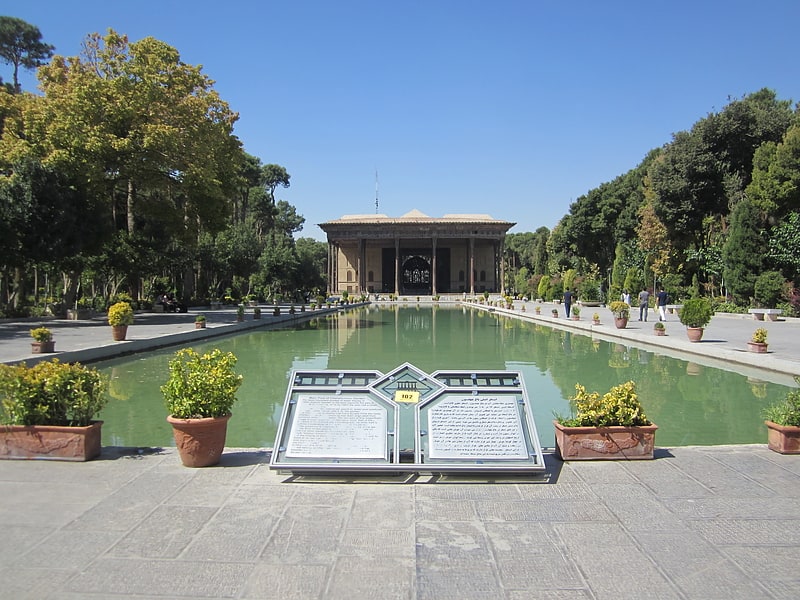
Also known as: چهلستون
Elegant, 17th-c. royal pavilion and garden. Chehel Sotoun is a Persian pavilion in the middle of a park at the far end of a long pool, in Isfahan, Iran, built by Shah Abbas II to be used for his entertainment and receptions. In this palace, Shah Abbas II and his successors would receive dignitaries and ambassadors, either on the terrace or in one of the stately reception halls.
The name, meaning "Forty Columns" in Persian, was inspired by the twenty slender wooden columns supporting the entrance pavilion, which, when reflected in the waters of the fountain, is said to appear to be forty.
As with Ali Qapu, the palace contains many frescoes and paintings on ceramic. Many of the ceramic panels have been dispersed and are now in the possession of major museums in the west. They depict specific historical scenes such as the infamous Battle of Chaldiran against the Ottoman Sultan Selim I, the reception of an Uzbek King in 1646, when the palace had just been completed; the welcome extended to the Mughal Emperor, Humayun who took refuge in Iran in 1544; the battle of Taher-Abad in 1510 where the Safavid Shah Ismail I vanquished and killed the Uzbek King. A more recent painting depicts Nader Shah's victory against the Indian Army at Karnal in 1739. There are also less historical, but even more aesthetic compositions in the traditional miniature style which celebrate the joy of life and love.
The Chehel Sotoun Palace is among the 9 Iranian Gardens which are collectively registered as one of the Iran’s 23 registered World Heritage Sites under the name of the Persian Garden.[10]
Address: Imam Hossein Square, Isfahan
National Museum of Damascus, Damascus
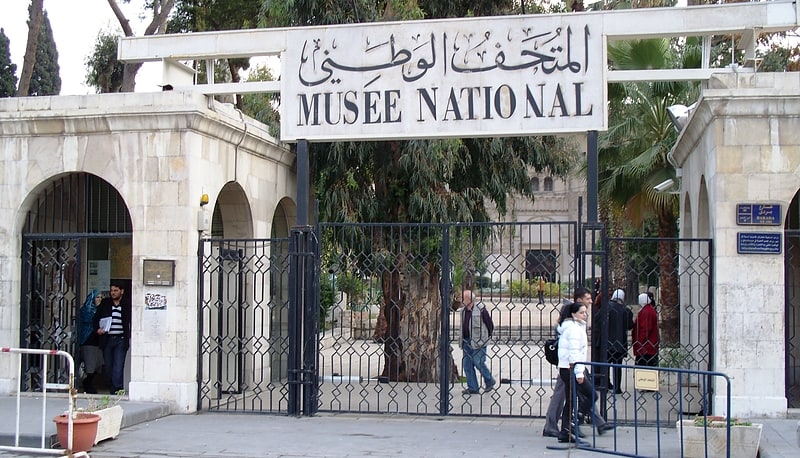
Also known as: المتحف الوطني بدمشق
Museum of Syrian history and art. The National Museum of Damascus is a museum in the heart of Damascus, Syria. As the country's national museum as well as its largest, this museum covers the entire range of Syrian history over a span of over 11 millennia. It displays various important artifacts, relics and major finds most notably from Mari, Ebla and Ugarit, three of Syria's most important ancient archaeological sites. Established in 1919, during King Faisal's Arab Kingdom of Syria, the museum is the oldest cultural heritage institution in Syria.
Among the museum's highlights are, the Dura-Europos synagogue, a reconstructed synagogue dated to 245 AD, which was moved piece by piece to Damascus in the 1930s, and is noted for its vibrant and well preserved wall paintings and frescoes, as well as sculptures and textiles from central Palmyra, and statues of the Greek goddess of victory from southern Syria. The museum houses over 5000 cuneiform tablets, among them the first known alphabet in history, written down on a clay tablet, the Ugaritic alphabet. The museum is further adorned by 2nd-century murals, elaborate tombs, and the recently restored Lion of al-Lat, which originally stood guard at the National Museum of Palmyra, but was moved to Damascus for safeguarding.
The museum temporarily closed its doors in 2012, after the Syrian Civil War engulfed Damascus and threatened its rich cultural artifacts. The museum authorities quickly unloaded more than 300,000 artifacts and hid them in secret locations to safeguard Syria's cultural heritage from destruction and looting. After six years, the museum reopened four of its five wings on October 29, 2018.[11]
Address: Shoukry Al-Qouwatly, Damascus
Black Stone, Mecca
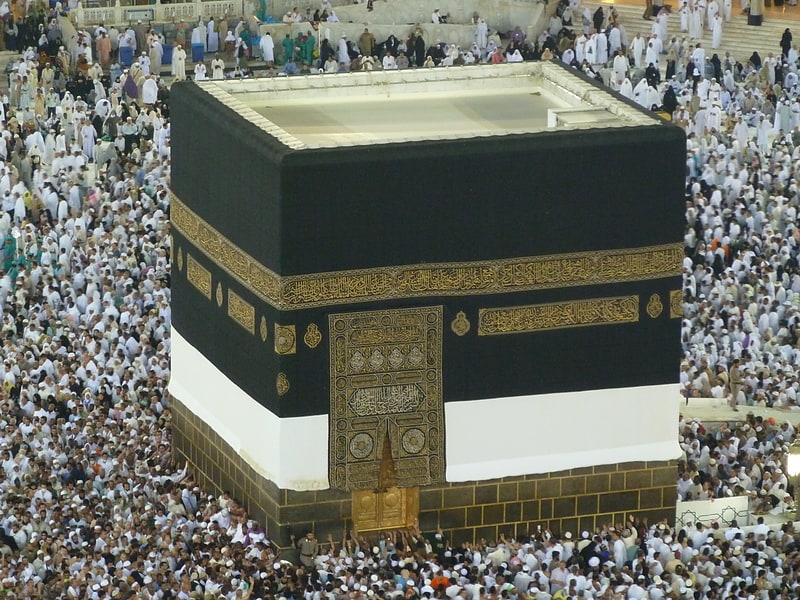
Also known as: الحجر الأسود
The Black Stone is a rock set into the eastern corner of the Kaaba, the ancient building in the center of the Grand Mosque in Mecca, Saudi Arabia. It is revered by Muslims as an Islamic relic which, according to Muslim tradition, dates back to the time of Adam and Eve.
The stone was venerated at the Kaaba in pre-Islamic pagan times. According to Islamic tradition, it was set intact into the Kaaba's wall by the Islamic prophet Muhammad in 605 CE, five years before his first revelation. Since then it has been broken into fragments and is now cemented into a silver frame in the side of the Kaaba. Its physical appearance is that of a fragmented dark rock, polished smooth by the hands of pilgrims. Islamic tradition holds that it fell from heaven as a guide for Adam and Eve to build an altar. It has often been described as a meteorite.
Muslim pilgrims circle the Kaaba as a part of the tawaf ritual during the hajj and many try to stop to kiss the Black Stone, emulating the kiss that Islamic tradition records that it received from Muhammad. Muslims do not worship the Black Stone.[12]
Address: Al Masjid Al Haram, Mecca
Golestan Palace, Tehran
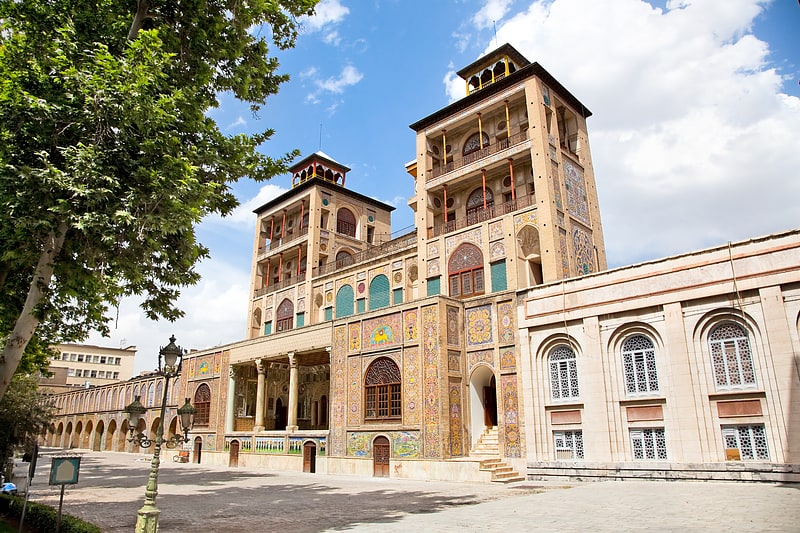
Also known as: کاخ گلستان
16th century palace and museum in citadel. The Golestan Palace, also known as the Gulistan Palace and sometimes known as the Rose Garden Palace, is the former royal Qajar complex in Iran's capital city, Tehran.
One of the oldest historic monuments in the city of Tehran, and of world heritage status, the Golestan Palace belongs to a group of royal buildings that were once enclosed within the mud-thatched walls of Tehran's arg ("citadel"). It consists of gardens, royal buildings, and collections of Iranian crafts and European presents from the 18th and 19th centuries.[13]
Address: Arq Suquare, 11369 Tehran
Jameh Mosque of Isfahan, Isfahan
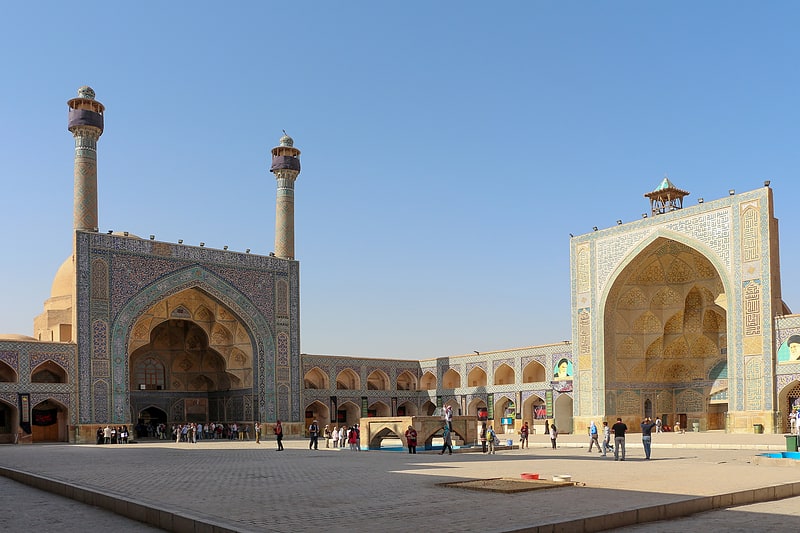
Also known as: مسجد جامع اصفهان
Mosque known for its varied architecture. The Jāmeh Mosque of Isfahān or Jāme' Mosque of Isfahān, also known as the Atiq Mosque and the Friday Mosque of Isfahān, is a historic congregational mosque of Isfahan, Iran. The mosque is the result of continual construction, reconstruction, additions and renovations on the site from around 771 to the end of the 20th century. The Grand Bazaar of Isfahan can be found towards the southwest wing of the mosque. It has been a UNESCO World Heritage Site since 2012. It is one of the largest and most important monuments of Islamic architecture in Iran.[14]
Address: Esfahan Bazaar, 81464 Isfahan
Al-Shallal Theme Park, Jeddah
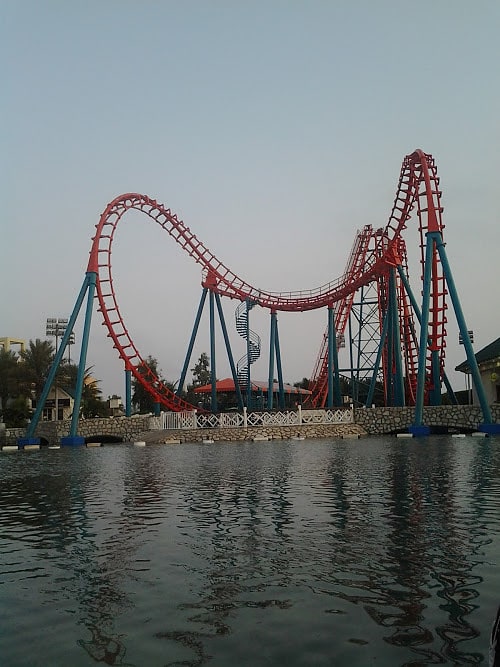
Amusement park in Jeddah, Saudi Arabia. Al-Shallal Theme Park is located in Jeddah, Saudi Arabia. The park is often referred to as "Fakieh Poultry Farms", which is the name of the owners of the park. The park officially opened on June 28, 2005. In 2001, Fakieh Poultry Farms ranked as the 34th largest company in Saudi Arabia with over $480 million in assets and over 6000 employees.[15]
Address: Al Kurnaysh Rd, 23413 Jeddah (أبحر)
Umayyad Mosque, Damascus
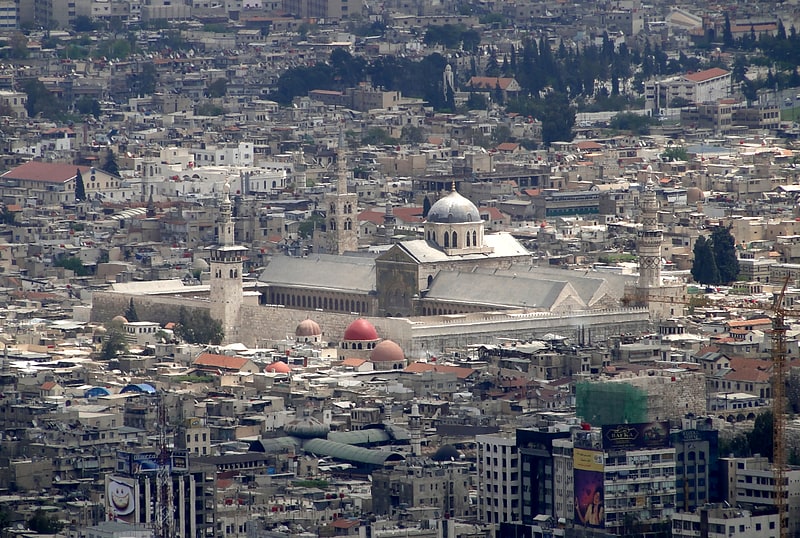
Also known as: الجامع الأموي
Landmark ancient mosque and burial site. The Umayyad Mosque, also known as the Great Mosque of Damascus, located in the old city of Damascus, is one of the largest and oldest mosques in the world. Its religious importance stems from the eschatological reports concerning the mosque, and historic events associated with it. Christian and Muslim tradition alike consider it the burial place of John the Baptist's head, a tradition originating in the 6th century. Muslim tradition holds that the mosque will be the place Jesus will return before the End of Days. Two shrines inside the premises commemorate the Islamic prophet Muhammad's grandson Husayn ibn Ali.
The site has been used as a house of worship since the Iron Age, when the Arameans built on it a temple dedicated to their god of rain, Hadad. Under Roman rule, beginning in 64 CE, it was converted into the center of the imperial cult of Jupiter, the Roman god of rain, becoming one of the largest temples in Syria. When the empire in Syria transitioned to Christian Byzantine rule, Emperor Theodosius I (r. 379–395) transformed it into a cathedral and the seat of the second-highest ranking bishop in the Patriarchate of Antioch.
After the Muslim conquest of Damascus in 634, part of the cathedral was designated as a small prayer house (musalla) for the Muslim conquerors. As the Muslim community grew, the Umayyad caliph al-Walid I (r. 705–715) confiscated the rest of the cathedral for Muslim use, returning to the Christians other properties in the city as compensation. The structure was largely demolished and a grand congregational mosque complex was built in its place. The new structure was built over nine years by thousands of laborers and artisans from across the Islamic and Byzantine empires at considerable expense and was funded by the war booty of Umayyad conquests and taxes on the Arab troops of Damascus. Unlike the simpler mosques of the time, the Umayyad Mosque had a large basilical plan with three parallel aisles and a perpendicular central nave leading from the mosque's entrance to the world's second concave mihrab (prayer niche). The mosque was noted for its rich compositions of marble paneling and its extensive gold mosaics of vegetal motifs, covering some 4,000 square metres (43,000 sq ft), likely the largest in the world.
Under Abbasid rule (750–860), new structures were added, including the Dome of the Treasury and the Minaret of the Bride, while the Mamluks (1260–1516) undertook major restoration efforts and added the Minaret of Qaytbay. The Umayyad Mosque innovated and influenced nascent Islamic architecture, with other major mosque complexes, including the Great Mosque of Cordoba in Spain and the al-Azhar Mosque of Egypt, based on its model. Although the original structure has been altered several times due to fire, war damage and repairs, it is one of the few mosques to maintain the same form and architectural features of its 8th-century construction, as well as its Umayyad character.[16]
Address: Old City, Damascus
Dizengoff Street, Tel Aviv

Also known as: רחוב דיזנגוף
Street in Tel Aviv, Israel. Dizengoff Street is a major street in central Tel Aviv, named after Tel Aviv's first mayor, Meir Dizengoff.
The street runs from the corner of Ibn Gabirol Street in its southernmost point to the port area of Tel Aviv in its northwestern point. Dizengoff Street is one of the most important streets in Tel Aviv, and has played an essential role in the development of the city. Since the 1970s, Dizengoff Street has suffered urban decay.[17]
Address: Dizengoff St, Tel Aviv
Dizengoff Center, Tel Aviv
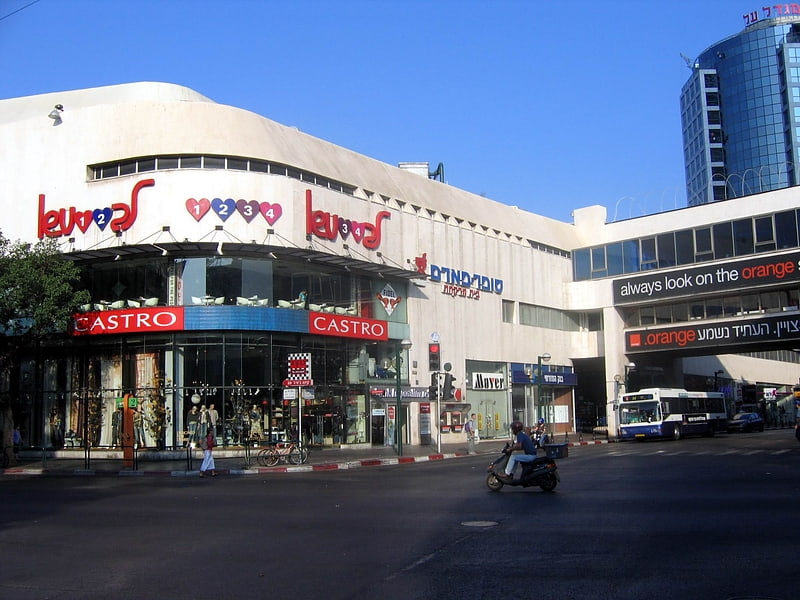
Also known as: דיזנגוף סנטר
Shopping mall in Tel Aviv, Israel. Dizengoff Center is a shopping mall at the intersection of Dizengoff Street and King George Street in Tel Aviv, Israel. The mall is named for Meir Dizengoff, the first mayor of Tel Aviv.[18]
Address: 50 Dizengoff St., 6433222 תל אביב-יפו
Qasr al-Bint, Petra
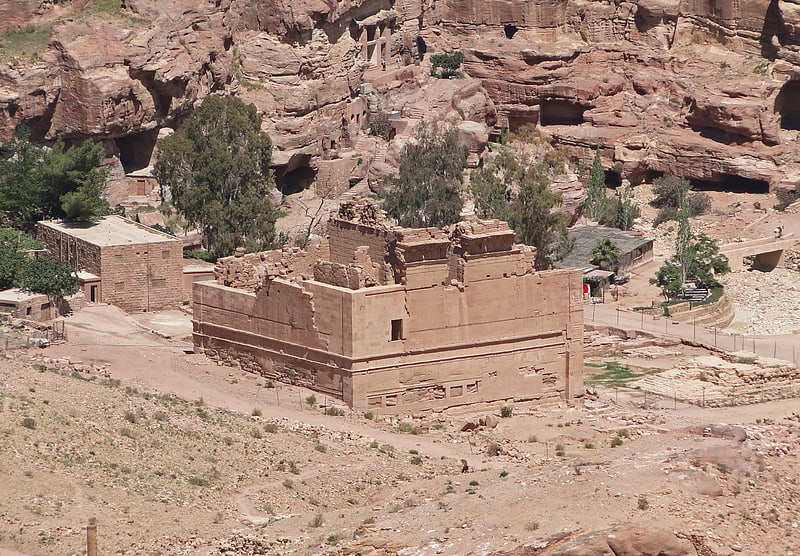
Historical landmark in Jordan. The Qasr al-Bint is a religious temple in the Nabataean city of Petra. It faces the Wadi Musa and is located to the northwest of the Great Temple and to the southwest of the Temple of the Winged Lions. One of the best preserved of the ancient structures surviving in Petra today, it stands near the monumental gate and was a key focal point on the colonnaded street, as well as a focus of religious worship.[19]
Ramat Gan Safari, Tel Aviv
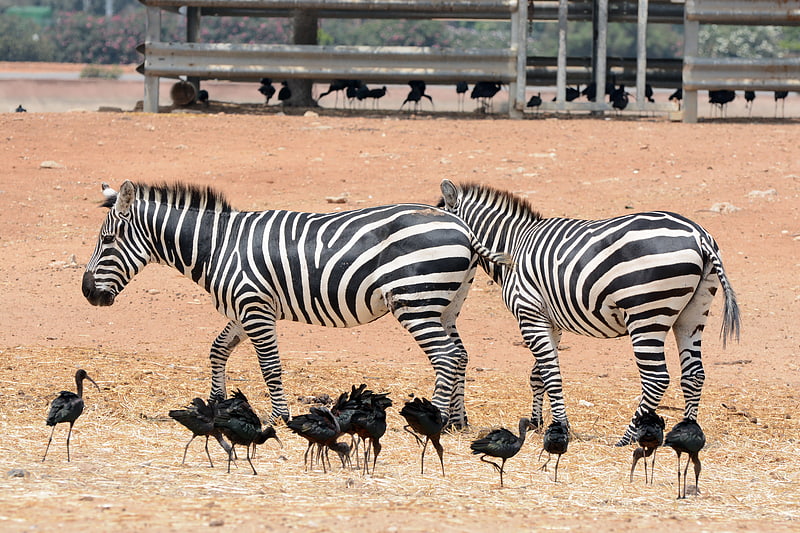
Also known as: הספארי ברמת גן
Zoo known for its drive-thru animal park. The Zoological Center Tel Aviv-Ramat Gan in the Tel Aviv District city of Ramat Gan, Israel is the largest collection of wildlife in human care in the Middle East. The 250-acre site consists of both a drive-through African safari area and a modern outdoor zoo. The African animal park opened to the general public in 1974. In 1981, the zoo was established in the middle of the park to replace the Tel Aviv Zoo, which had closed down.
Ramat Gan Safari houses 83 species of mammals, 92 species of birds and 23 species of reptiles. Among other outstanding groups of animals, it has white rhinos, hippos, lions, African and Asian elephants, gorillas, orangutans, and a Komodo dragon. The animals are seen in open air enclosures amid subtropical gardens.
The Ramat Gan Safari has sent animals to the Qalqilya Zoo in the West Bank of the Palestinian territories and maintains close ties with the veterinarians in the Palestinian Authority.
It has more than 700,000 visitors annually from all social and ethnic groups of Israel as well as tourists from abroad.[20]
Address: Hatsfi Avenue, Tel Aviv
Azerbaijan Museum, Tabriz
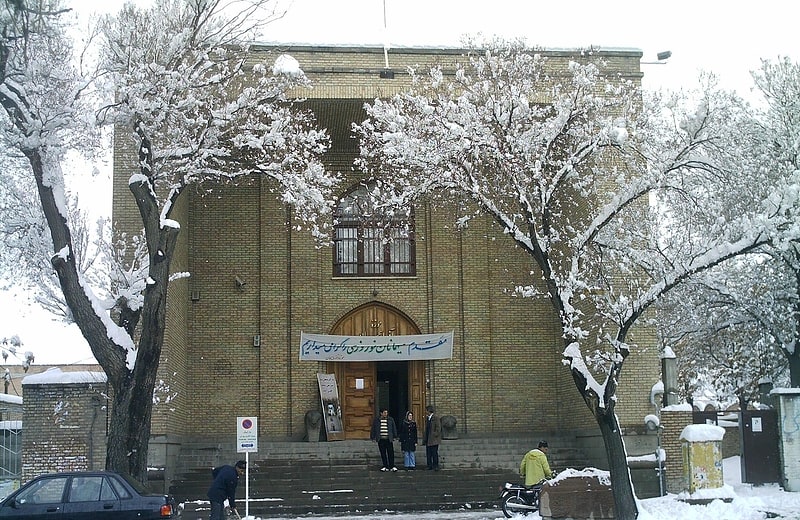
Also known as: موزه آذربایجان
Museum in Tabriz, Iran. Azerbaijan Museum is the major archaeological and historical museum in Tabriz, in the northwest part of Iran. It was established on April 1958. The museum consists of three major halls, a side yard, office rooms and a library. It mostly contains objects discovered from excavations in Iranian Azerbaijan, also some artworks and sculptures of artists. Its library contains more than 2500 books, both handwritten and printed, about history, archaeology, art and Iranian culture. Apart from National Museum of Iran in Tehran, Azerbaijan Museum has the largest collection belonging to different periods of Iran's history.[21]
Address: مصلای بزرگ تبریز, Tabriz
Beirut Souks, Beirut
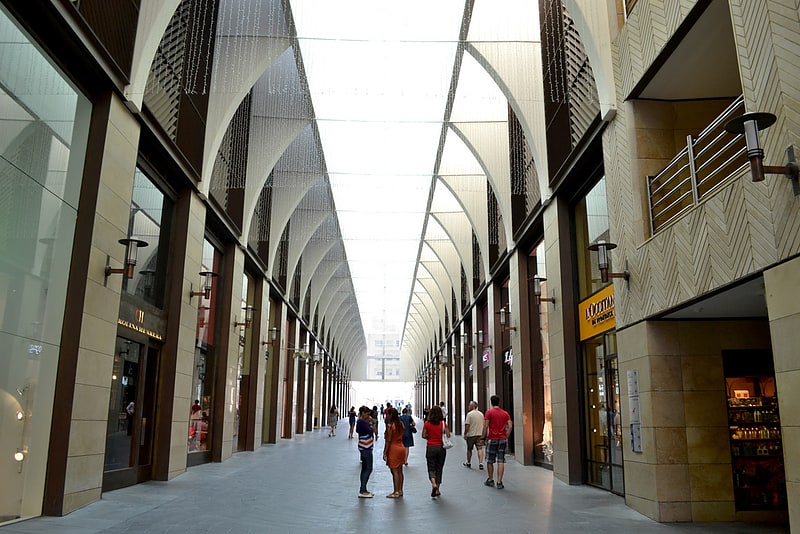
Also known as: أسواق بيروت
Shopping center in Beirut, Lebanon. Beirut Souks is a major commercial district in Beirut Central District. With over 200 shops, 25 restaurants and cafes, an entertainment center, a 14 cinema complex, periodic street markets and an upcoming department store, it is Beirut's largest and most diverse shopping and leisure area. Beirut Souks also features piazzas and public space. Designed in five separate commissions by international and Lebanese architects, Beirut Souks offer 128,000 sq. m of built-up area interspersed with landscaped pedestrian zones.
The souks have historically been at the commercial heart of Beirut. They sustained severe damage during the Lebanese Civil War and were rebuilt by Solidere according to the ancient Greek street grid, maintaining the historic landmarks and pre-war street names.[22]
Address: Souk El Bazerkan, Beirut
Shrine of the Báb, Haifa
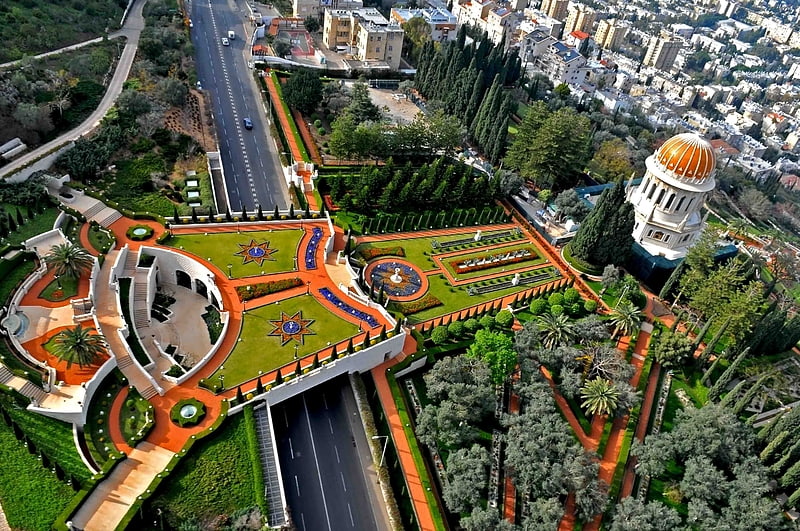
Also known as: מקדש הבאב
Domed-shaped edifice with sacred remains. The Shrine of the Báb is a structure on the slopes of Mount Carmel in Haifa, Israel, where the remains of the Báb, founder of the Bábí Faith and forerunner of Baháʼu'lláh in the Baháʼí Faith, are buried; it is considered to be the second holiest place on Earth for Baháʼís, after the Shrine of Baháʼu'lláh in Acre. Its precise location on Mount Carmel was designated by Baháʼu'lláh himself to his eldest son, ʻAbdu'l-Bahá, in 1891. ʻAbdu'l-Bahá planned the structure, which was designed and completed several years later by his grandson, Shoghi Effendi.
Crowning the design, as anticipated by ʻAbdu'l-Bahá, is a dome, which is set on an 18-windowed drum. That, in turn, is mounted on an octagon, a feature suggested by Shoghi Effendi. An arcade surrounds the stone edifice. A restoration project of the exterior and interior of the shrine started in 2008 and was completed in April 2011.[23]
Shams-ol-Emareh, Tehran
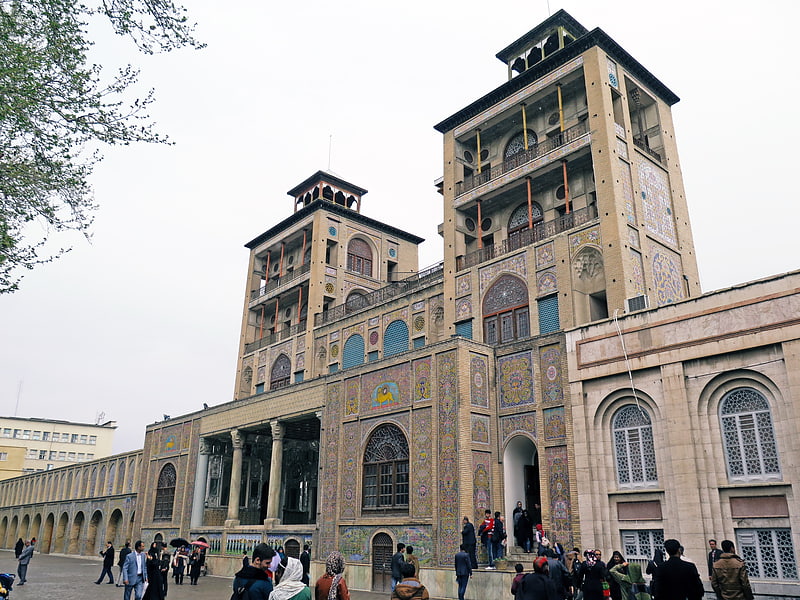
Building in Tehran, Iran. Shams-ol-Emareh is one of Tehran’s historical buildings and a remnant of Qajar Dynasty. It is one of the most prominent buildings on the east side of Golestan Palace. It was built around 1830. It is notable for its height, decorations and design.
Shams-ol-Emareh is 35 meters tall with five floors. It was the tallest building in Tehran when it was built, and the first building using metal in its structure. All the pillars in the upper floors are of cast iron. Shams-ol-Emareh was the symbol of Tehran before Sar dar Baghe Melli was built.[24]
Azm Palace, Damascus
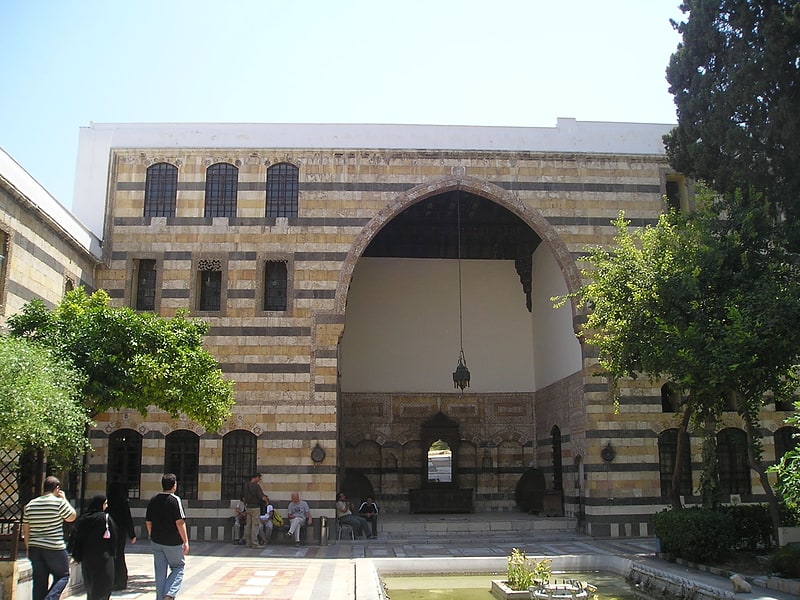
Also known as: قصر العظم
Palace in Damascus, Syria. Azm Palace is a palace in Damascus, Syria which dates back to the 18th century. Located north of Al-Buzuriyah Souq in the Ancient City of Damascus, the palace was built in 1749 and was the private residence for As'ad Pasha al-Azm, the governor of Damascus, and during the French Mandate for Syria and the Lebanon it housed the French Institute.
After being purchased by the Syrian government from the Al-Azm family and undergoing several reconstruction works, the palace now houses the Museum of Arts and Popular Traditions.[25]
Address: Damascus, Al-Buzuriyah Souq
Ālī Qāpū, Isfahan
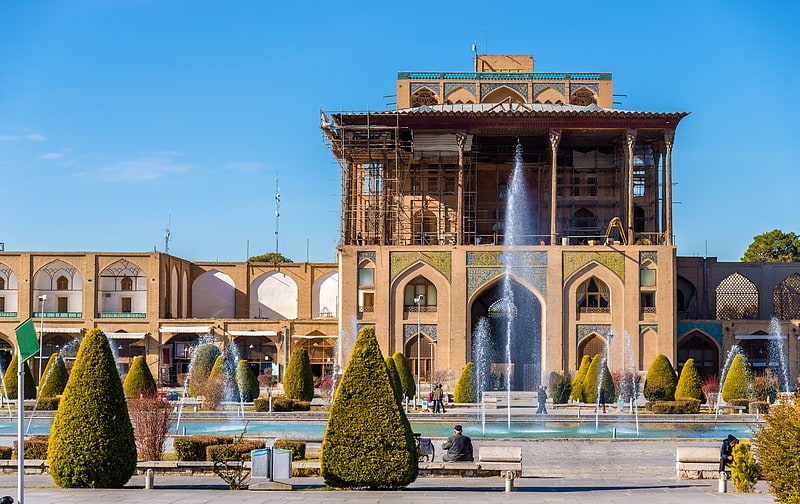
Also known as: عالیقاپو
Majestic palace with a lavish music room. Ali Qapu Palace or the Grand Ālī Qāpū is an imperial palace in Isfahan, Iran. It is located on the western side of the Naqsh-e Jahan Square, opposite to Sheikh Lotfollah Mosque, and had been originally designed as a vast portal entrance to the grand palace which stretched from the Naqsh-e Jahan Square to the Chahar Baq Boulevard. The palace served as the official residence of Persian Emperors of the Safavid dynasty. UNESCO inscribed the Palace and the Square as a World Heritage Site due to its cultural and historical importance. The palace is forty-eight meters high and there are six floors, each accessible by a difficult spiral staircase. In the sixth floor, Music Hall, deep circular niches are found in the walls, having not only aesthetic value, but also acoustic. Ālī Qāpū is regarded as the best example of Safavid architecture and a symbol of Iran's Islamic heritage.
The name Ali Qapu, from Persian ‘Ālī (meaning "imperial" or "great"), and Azerbaijani Qāpū (meaning "gate"), was given to this place as it was right at the entrance to the Safavid palaces which stretched from the Naqsh-e Jahan Square to the Chahar Baq Boulevard. The building, another wonderful Safavid edifice, was built by decree of Shah Abbas I in the early seventeenth century. It was here that the great monarch used to entertain noble visitors, and foreign ambassadors. Shah Abbas, here for the first time, celebrated the Nowruz (Iranian New Year) of 1006 AH / 1597 C.E.
Ali Qapu is rich in naturalistic wall paintings by Reza Abbasi, the court painter of Shah Abbas I, and his pupils. There are floral, animal, and bird motifs in his works. The highly ornamented doors and windows of the palace have almost all been pillaged at times of social anarchy. Only one window on the third floor has escaped the ravages of time. Ali Qapu was repaired and restored substantially during the reign of Shah Sultan Hussein, the last Safavid ruler, but fell into a dreadful state of dilapidation again during the short reign of invading Afghans. Under the reign of Naser ad-Din Shah the Qajar (1848–96), the Safavid cornices and floral tiles above the portal were replaced by tiles bearing inscriptions.
Shah Abbas II was enthusiastic about the embellishment and perfection of Ali Qapu. His chief contribution was given to the magnificent hall, the constructors on the third floor. The 18 columns of the hall are covered with mirrors and its ceiling is decorated with great paintings.
The chancellery was stationed on the first floor. On the sixth, the royal reception and banquets were held. The largest rooms are found on this floor. The stucco decoration of the banquet hall abounds in motif of various vessels and cups. The sixth floor was popularly called the Music Hall. Here various ensembles performed music and sang songs.
From the upper galleries, the Safavid ruler watched Chowgan (polo), army maneuvers and horse-racing in the Naqsh-e Jahan square.
The palace is depicted on the reverse of the Iranian 20,000 rials banknote. The palace is also depicted on the reverse of the Iranian 20 rials 1953 banknote series.[26]
Address: Naghshe Jahan Sq,Sepah St, Imam Hossein Square, 4 Bagh St, Isfahan, Iran, 81464 Isfahan
Madatech, Haifa

Also known as: מדעטק - המוזיאון הלאומי למדע, טכנולוגיה וחלל
Museum in Haifa, Israel. The Israel National Museum of Science, Technology, and Space is a science and technology museum in the city of Haifa, Israel. The museum has approximately 200,000 visitors annually.[27]
Address: Rehov Balfour 25, 3144801 Haifa
Jeddah Corniche, Jeddah
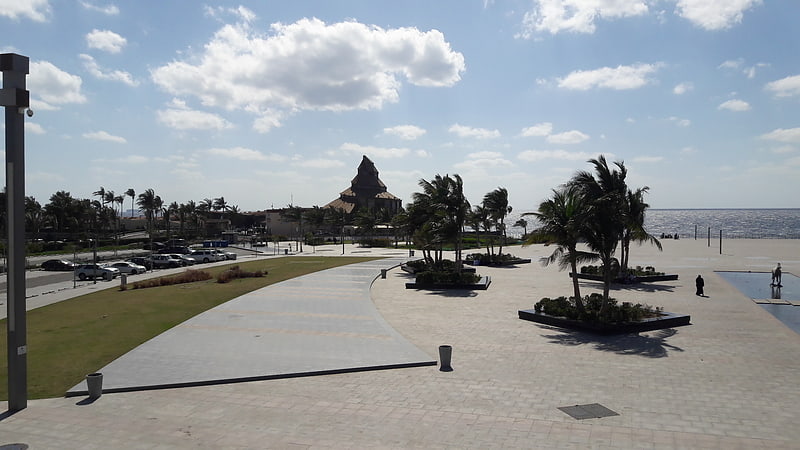
The Jeddah Corniche, also known as the Jeddah Waterfront, is a 30 km coastal resort area of the city of Jeddah, Saudi Arabia. Located along the Red Sea, the corniche features a coastal road, recreation areas, pavilions and large-scale civic sculptures as well as King Fahd's Fountain, the highest fountain in the world. Also located here is the Al-Rahmah Mosque, which is a popular attraction to visitors.
The Jeddah Corniche derives its name from the original French and Italian term for a coastal road, especially a road along the face of a cliff.
In November 2017, the waterfront was inaugurated for visitors with the goal of being a tourist attraction in the city. It was launched as a response to a royal decree with the aim of improving the public facilities of the city of Jeddah. The established area is equipped with many facilities including restaurants, retail outlets, hotels, aquarium, cultural centre, water dancing fountain, blossoming gardens and fountains.[28]
Church of the Nativity, Bethlehem
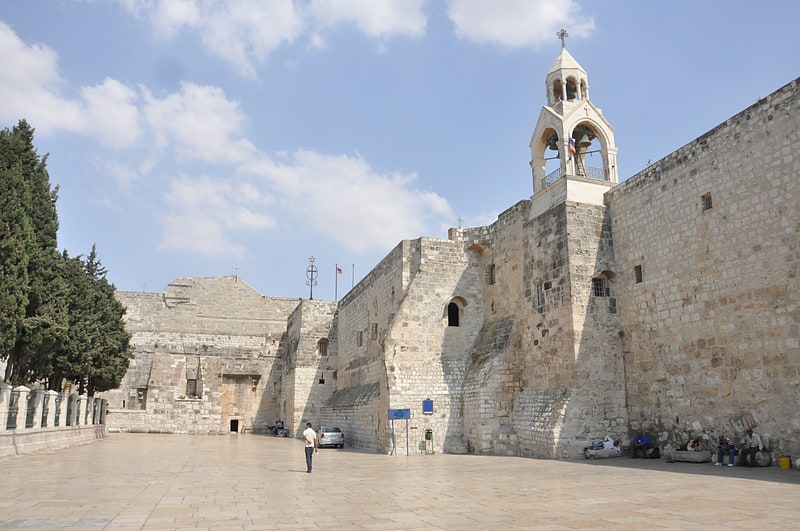
Also known as: כנסיית המולד
Storied, ancient 4th-century church. The Church of the Nativity, or Basilica of the Nativity, is a basilica located in Bethlehem in the West Bank, Palestine. The grotto it contains holds a prominent religious significance to Christians of various denominations as the birthplace of Jesus. The grotto is the oldest site continuously used as a place of worship in Christianity, and the basilica is the oldest major church in the Holy Land.
The church was originally commissioned by Constantine the Great a short time after his mother Helena's visit to Jerusalem and Bethlehem in 325–326, on the site that was traditionally considered to be the birthplace of Jesus. That original basilica was likely built between 330 and 333, being already mentioned in 333, and was dedicated on 31 May 339. It was destroyed by fire during the Samaritan revolts of the sixth century, possibly in 529, and a new basilica was built a number of years later by Byzantine Emperor Justinian (r. 527–565), who added a porch or narthex, and replaced the octagonal sanctuary with a cruciform transept complete with three apses, but largely preserved the original character of the building, with an atrium and a basilica consisting of a nave with four side aisles.
The Church of the Nativity, while remaining basically unchanged since the Justinianic reconstruction, has seen numerous repairs and additions, especially from the Crusader period, such as two bell towers (now gone), wall mosaics and paintings (partially preserved). Over the centuries, the surrounding compound has been expanded, and today it covers approximately 12,000 square meters, comprising three different monasteries: one Roman Catholic, one Armenian Apostolic, and one Greek Orthodox, of which the first two contain bell towers built during the modern era.
The silver star marking the spot where Christ was born, inscribed in Latin, was stolen in October 1847 by Greek monks who wished to remove this Catholic item. Some assert that this was a contributing factor in the Crimean War against the Russian Empire. Others assert that the war grew out of the wider European situation.
Since 2012, the Church of the Nativity is a World Heritage Site and was the first to be listed by UNESCO under 'Palestine'.
A 250-year-old understanding among religious communities, the Status Quo, applies to the site.[29]
Address: Manger Sq., Bethlehem
Eram Garden, Shiraz

Also known as: باغ ارم
Paved, manicured gardens with palm trees. Eram Garden is a historic Persian garden in Shiraz, Iran. The garden, and the building within it, are located at the northern shore of the Khoshk River in the Fars province.[30]
Address: Eram St, Shiraz
Verdun, Beirut
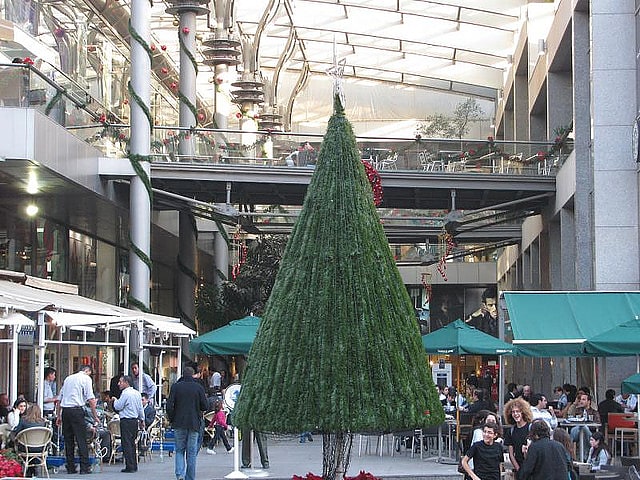
Also known as: الفردان
Street in Beirut, Lebanon. Rue Verdun, or Verdun Street, is an upscale commercial and residential street in Beirut, Lebanon. The street, which is a major shopping center and tourist attraction, was named in honor of the Battle of Verdun during World War I. It is officially named Rachid Karami Street, after Lebanon's late Prime Minister who was assassinated during the Lebanese Civil War.[31]
Blue Mosque, Tabriz
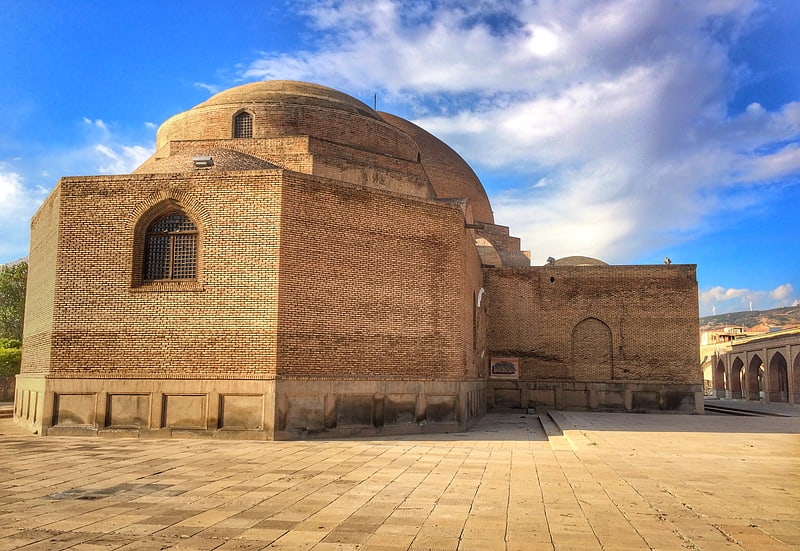
Also known as: مسجد کبود
15th-century mosque with ornate mosaics. The Blue Mosque is a historic mosque in Tabriz, Iran. The mosque and some other public buildings were constructed in 1465 upon the order of Jahan Shah, the ruler of Kara Koyunlu.
The mosque was severely damaged in an earthquake in 1780, leaving only the iwan (entrance hall). Reconstruction began in 1973 by Reza Memaran Benam under the supervision of Iranian Ministry of Culture. However, it is still incomplete.[32]
Address: Imam Khomeyni, Tabriz
Azadi Tower, Tehran

Also known as: برج آزادی
Tower with museum and observation deck. The Azadi Tower, formerly known as the Shahyad Tower, is a monument located on Azadi Square in Tehran, Iran. It is one of the landmarks of Tehran, marking the west entrance to the city, and is part of the Azadi Cultural Complex, which also includes an underground museum.
The tower is about 45 metres (148 ft) tall and is completely clad in cut marble. It was commissioned by Mohammad Reza Pahlavi, the last Shah of Iran, to mark the 2,500-year celebration of the Persian Empire and completed in 1971.
After winning a competition, architect Hossein Amanat was tasked to design the tower. His ideas were based upon classical and post-classical Iranian architecture, popular influences on art in the 1960s following the White Revolution. Iran's increasing wealth sparked modernization programs and sent the art industry into a renaissance-like period.[33]
Address: Azadi Square, 11369 Tehran
National Museum of Beirut, Beirut
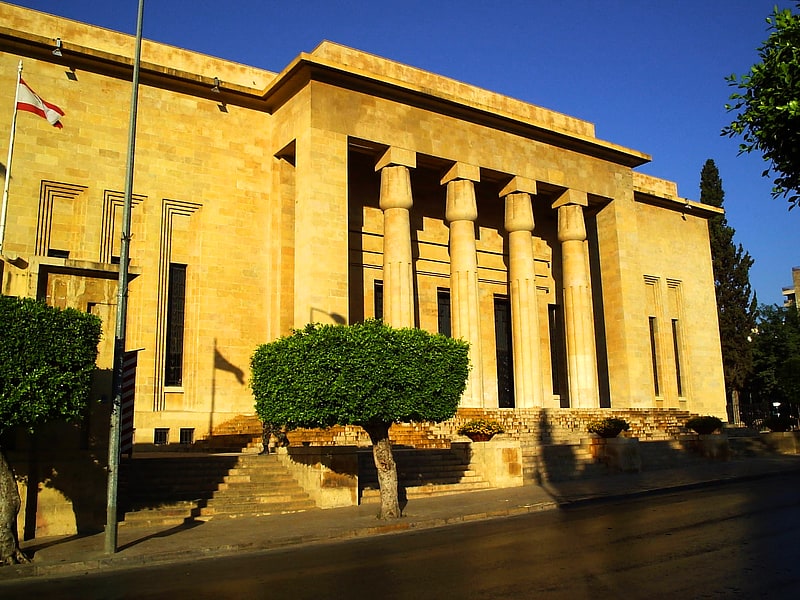
Also known as: متحف بيروت الوطني
Lebanon's history told through exhibits. The National Museum of Beirut is the principal museum of archaeology in Lebanon. The collection begun after World War I, and the museum was officially opened in 1942. The museum has collections totaling about 100,000 objects, most of which are antiquities and medieval finds from excavations undertaken by the Directorate General of Antiquities. About 1300 artifacts are exhibited, ranging in date from prehistoric times to the medieval Mamluk period.
During the 1975 Lebanese Civil War, the museum stood on the front line that separated the warring factions. The museum's Egyptian Revival building and its collection suffered extensive damage in the war, but most of the artifacts were saved by last-minute preemptive measures.
Today, after a major renovation, the National Museum of Beirut has regained its former position, especially as a leading collector for ancient Phoenician objects.[34]
Address: Museum Street, Beirut
Hira, Mecca
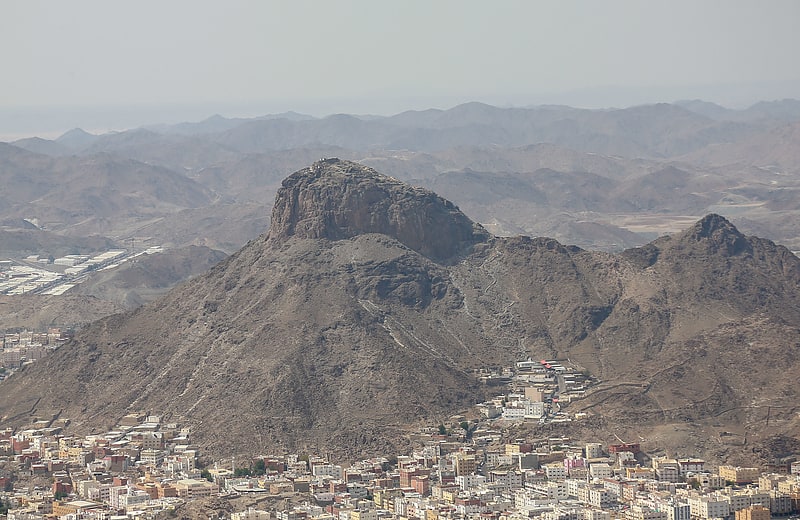
Mountain in Saudi Arabia. Jabal an-Nour is a mountain near Mecca in the Hejaz region of Saudi Arabia. The mountain houses the grotto or cave of Hira', which holds tremendous significance for Muslims throughout the world, as the Islamic prophet Muhammad is said to have spent time in this cave meditating, and it is widely believed that it was here that he received his first revelation, which consisted of the first five ayats of Surah Al-Alaq from the angel Jibra'il. It is one of the most popular tourist attractions in Makkah. The mountain itself is barely 640 m tall; nonetheless one to two hours are needed to make the strenuous hike to the cave. There are 1750 steps to the top which, even for a fit individual, can take anywhere between half an hour and one-and-a-half hours.[35]
Address: Ghar Hira, Jabl-e-noor, 24238 Makkah
Tahlia Street, Jeddah
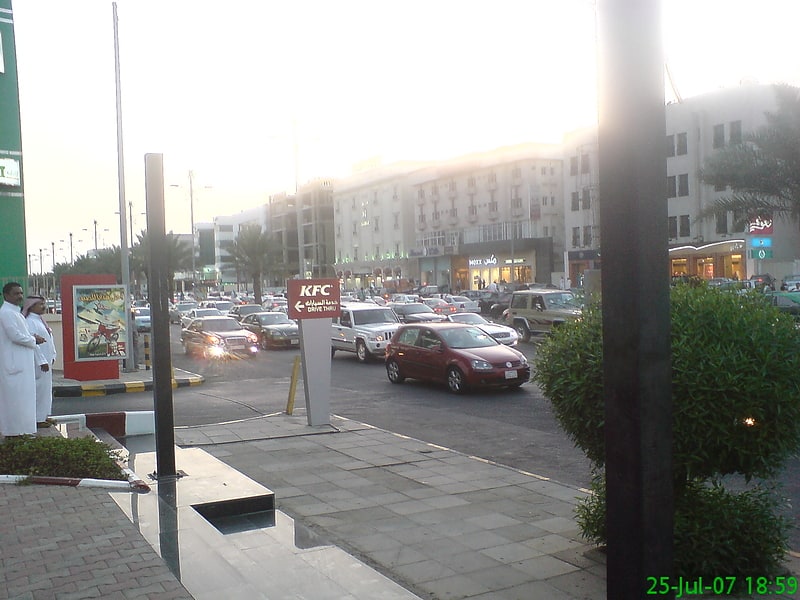
Also known as: شارع الأمير محمد بن عبدالعزيز
Street in Jeddah, Saudi Arabia. Tahlia Street is a fashion and shopping street in the mid-town of Jeddah, Saudi Arabia.
The street contains many upscale department shops, and boutiques, such as Prada, Gucci, Versace, Cartier, Chanel, Louis Vuitton, Dolce & Gabbana, Ralph Lauren and Giorgio Armani. As the Champs-Élysées is for Paris, Tahlia Street is believed to be the heart of Jeddah and Saudi Arabia's wealthiest district.
This commercial street is the destination of soccer fans, who drive up and down waving club scarves and sounding their car horns to celebrate victory.
An identically named street in Saudi Arabia's capital Riyadh, Prince Mohammed bin Abdulaziz Street, has been nicknamed Tahlia Street by the residents as it coincidentally shares many similarities with the original Tahlia Street in Jeddah.[36]
Address: Tahlia St, 23322 Jeddah (جدة الجديدة)
Bazaar of Tabriz, Tabriz

Also known as: بازار تبریز
Shopping center in Tabriz, Iran. The Bazaar of Tabriz is a historical market situated in the city center of Tabriz, Iran. It is one of the oldest bazaars in the Middle East and the largest covered bazaar in the world. It is one of Iran's UNESCO World Heritage Sites.[37]
Great Mosque of Mecca, Mecca
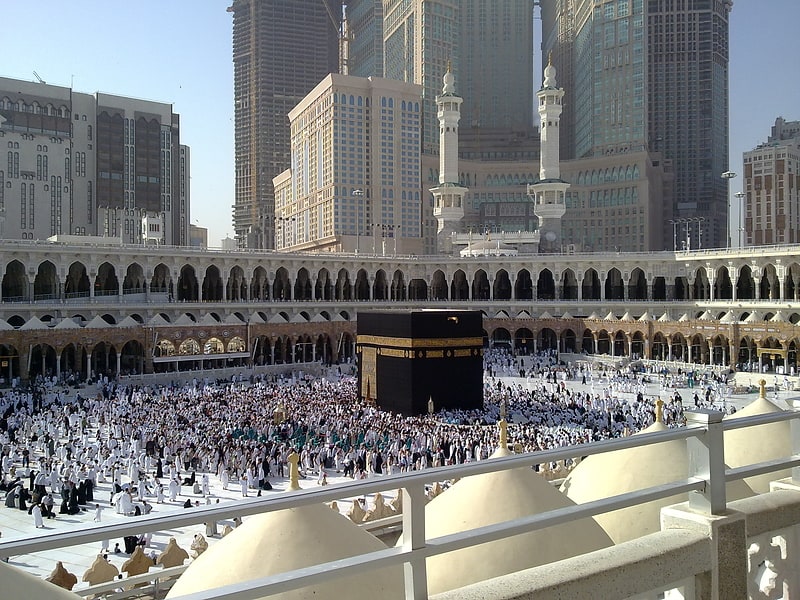
Also known as: المسجد الحرام
Great Mosque of Mecca. Masjid al-Haram, also known as the Great Mosque of Mecca, is a mosque that surrounds the Kaaba in Mecca, in the Mecca Province of Saudi Arabia. It is a site of pilgrimage in the Hajj, which every Muslim must do at least once in their lives if able, and is also the main phase for the ʿUmrah, the lesser pilgrimage that can be undertaken any time of the year. The rites of both pilgrimages include circumambulating the Kaaba within the mosque. The Great Mosque includes other important significant sites, including the Black Stone, the Zamzam Well, Maqam Ibrahim, and the hills of Safa and Marwa.
As of August 2020, the Great Mosque is the largest mosque and the eighth largest building in the world. It has undergone major renovations and expansions through the years. It has passed through the control of various caliphs, sultans and kings, and is now under the control of the King of Saudi Arabia who is titled the Custodian of the Two Holy Mosques.[38]
Al-Masjid an-Nabawi, Medina
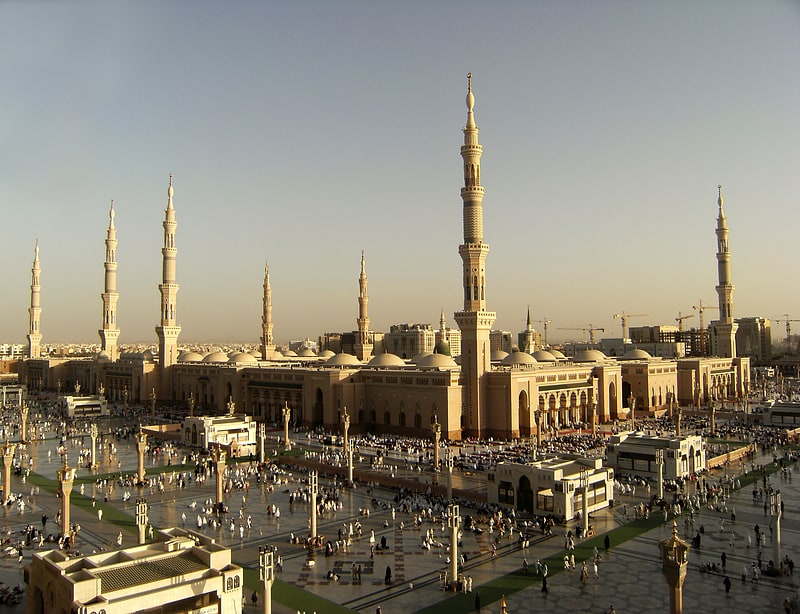
Also known as: المسجد النبوي
Mosque built by the prophet Muhammad. Al-Masjid an-Nabawi, known in English as The Prophet's Mosque, is a mosque built by the Islamic prophet Muhammad in the city of Medina in the Al Madinah Province of Saudi Arabia. It was the second mosque built by Muhammad in Medina, after Masjid Quba', and is the second largest mosque and second holiest site in Islam, both titles ranking after the Masjid al-Haram in Mecca. It is generally open regardless of date or time, and has only been closed to visitors once in modern times, as Ramadan approached during the 2020 COVID-19 pandemic.
The land of Al-Masjid an-Nabawi belonged to two young orphans, Sahl and Suhayl, and when they came to know that Muhammad wished to acquire their land for the purposes of erecting a mosque, they went to Muhammad and offered the land to him as a gift; Muhammad insisted on paying a price for the land because they were orphaned children. The price agreed upon was paid by Abu Ayyub al-Ansari, who thus became the endower or donor (Arabic: واقِف, romanized: waqif) of Al-Masjid an-Nabawi on behalf of, or in favor of, Muhammad. al-Ansari also accommodated Muhammad upon his arrival at Medina in 622.
Muhammad shared in the construction of the mosque. Originally an open-air building, the mosque served as a community center, a court of law, and a religious school. There was a raised platform or pulpit (minbar) for the people who taught the Quran and for Muhammad to give the Friday sermon (khutbah). Subsequent Islamic rulers greatly expanded and decorated the mosque, naming its walls, doors and minarets after themselves and their forefathers.
After an expansion during the reign of the Umayyad caliph Al-Walid I, it now incorporates the final resting place of Muhammad and the first two Rashidun caliphs Abu Bakr and Umar. One of the most notable features of the site is the Green Dome in the south-east corner of the mosque, originally Aisha's house, where the tomb of Muhammad is located. Many pilgrims who perform the Hajj also go to Medina to visit (Ziyarah) the Green Dome. In 1909, under the reign of Ottoman Sultan Abdul Hamid II, it became the first place in the Arabian Peninsula to be provided with electrical lights. The mosque is under the control of the Custodian of the Two Holy Mosques. The mosque is located at the heart of Medina and is a major pilgrimage site.[39]
Citadel of Aleppo, Aleppo
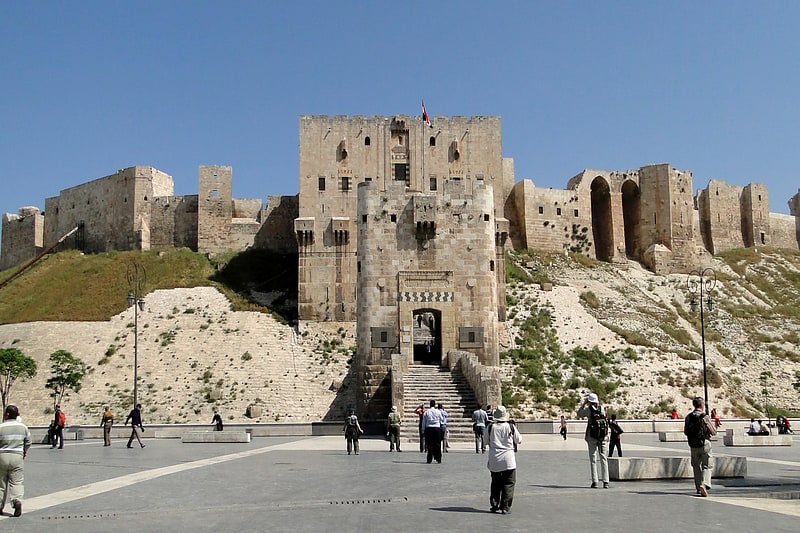
Also known as: قلعة حلب
Historical landmark in Aleppo, Syria. The Citadel of Aleppo is a large medieval fortified palace in the centre of the old city of Aleppo, northern Syria. It is considered to be one of the oldest and largest castles in the world. Usage of the Citadel hill dates back at least to the middle of the 3rd millennium BC. Occupied by many civilizations over time – including the Armenians, Greeks, Byzantines, Ayyubids, Mamluks and Ottomans – the majority of the construction as it stands today is thought to originate from the Ayyubid period. An extensive conservation work took place in the 2000s by the Aga Khan Trust for Culture, in collaboration with Aleppo Archeological Society. Dominating the city, the Citadel is part of the Ancient City of Aleppo, a UNESCO World Heritage Site since 1986. During the 2010s, the Citadel received significant damage during the lengthy Battle of Aleppo. It was reopened to the public in early 2017 with repairs to damaged parts underway.[40]
Address: Hawl Al Qalaa St, Aleppo
Great Mosque of Aleppo, Aleppo
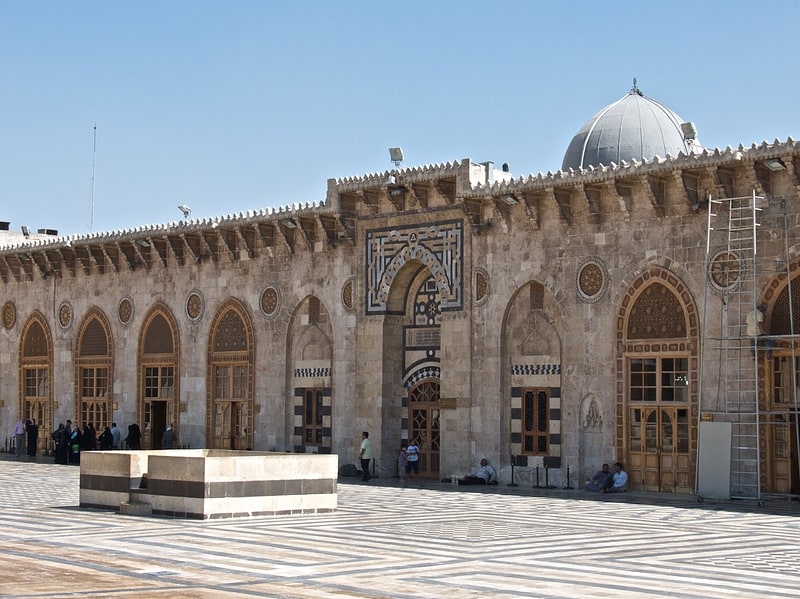
Also known as: جامع حلب الكبير
8th-century mosque with a courtyard. The Great Mosque of Aleppo is the largest and one of the oldest mosques in the city of Aleppo, Syria. It is located in al-Jalloum district of the Ancient City of Aleppo, a World Heritage Site, near the entrance to Al-Madina Souq. The mosque is purportedly home to the remains of Zechariah, the father of John the Baptist, both of whom are revered in Islam and Christianity. It was built in the beginning of the 8th century CE. However, the current building dates back to the 11th through 14th centuries. The minaret in the mosque was built in 1090, and was destroyed during fighting in the Syrian Civil War in April 2013.[41]
Address: Hawl Al Qalaa St, Aleppo
Universal House of Justice, Haifa
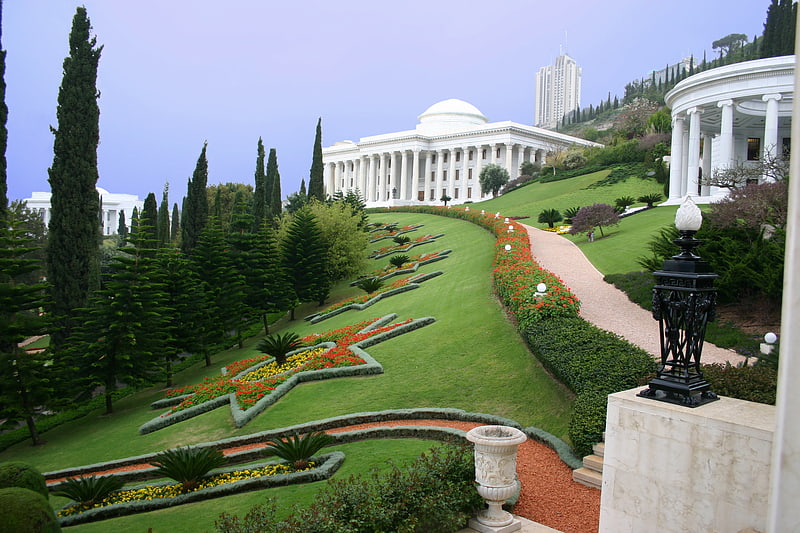
Also known as: בית הצדק העולמי
The Universal House of Justice is the nine-member supreme ruling body of the Baháʼí Faith. It was envisioned by Baháʼu'lláh, the founder of the Baháʼí Faith, as an institution that could legislate on issues not already addressed in the Baháʼí writings, providing flexibility for the Baháʼí Faith to adapt to changing conditions. It was first elected in 1963, and subsequently every five years, by delegates consisting of the members of Baháʼí National Spiritual Assemblies throughout the world.
The Universal House of Justice, as the head of the religion, has provided direction to the worldwide Baháʼí community primarily through a series of multi-year plans, as well as through annual messages delivered during the Ridván festival. The messages have focused on increasing the number of Local Spiritual Assemblies, translating Baháʼí literature, establishing Baháʼí Centres, completing Baháʼí Houses of Worship, holding international conferences, and developing educational systems to enhance literacy, the role of women, spirituality for children and youth, family life, social and economic development, and communal worship. The Universal House of Justice has also played a role in responding to systemic persecution of Baháʼís in Iran by garnering worldwide media attention.
The books and documents published by the Universal House of Justice are considered authoritative and its legislative decisions are considered infallible by Baháʼís. Although it is empowered to legislate on matters that are not addressed in the Baha'i holy writings, the Universal House of Justice has rarely exercised this function.
The Seat of the Universal House of Justice and its members reside in Haifa, Israel, on the slope of Mount Carmel. The most recent election was 29 April 2018. Although all other elected and appointed roles in the Baháʼí Faith are open to men and women, membership on the Universal House of Justice is male-only; the Baháʼí writings indicate that the reason for this will become clear in the future.[42]
Address: 61 Yefe Nof, 3464701 Haifa
Amman Citadel, Amman
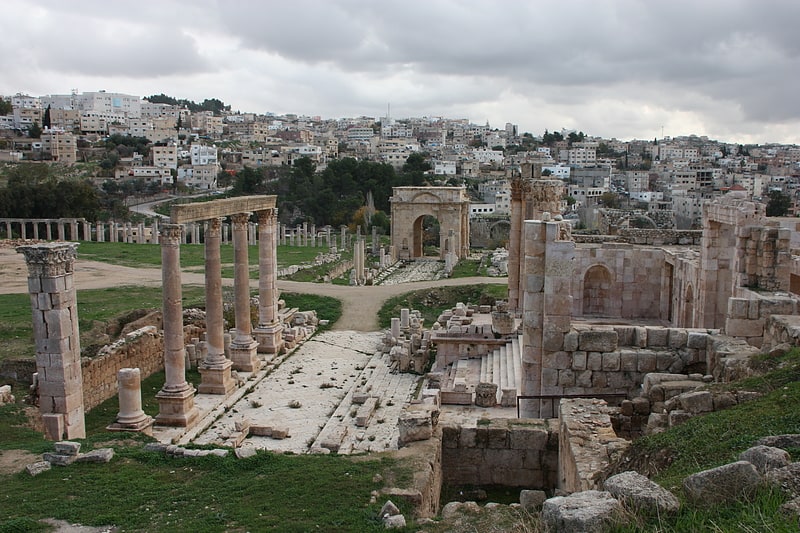
Also known as: جبل القلعة
Well-known historic site with ruins. The Amman Citadel is an archeological site at the center of downtown Amman, the capital of Jordan. The L-shaped hill is one of the seven hills that originally made up Amman.
The Citadel has a long history of occupation by many great civilizations. Evidence of inhabitance since the Neolithic period has been found and the hill was fortified during the Bronze Age (1800 BCE). The hill became the capital of the Kingdom of Ammon sometime after 1200 BCE. It later came under the sway of empires such as the Neo-Assyrian Empire (8th century BCE), Neo-Babylonian Empire (6th century BC), the Ptolemies, the Seleucids (3rd century BCE), Romans (1st century BCE), Byzantines (3rd century CE) and the Umayyads (7th century CE). After the Umayyads, came a period of decline and for much of the time until 1878 as the former city became an abandoned pile of ruins only sporadically used by Bedouins and seasonal farmers. Despite this gap, the Citadel of Amman is considered to be among the world's oldest continuously inhabited places.
Most of the structures still visible at the site are from the Roman, Byzantine, and Umayyad periods. The major remains at the site are the Temple of Hercules, a Byzantine church, and the Umayyad Palace. The Jordan Archaeological Museum was built on the hill in 1951. Though the fortification walls enclose the heart of the site, the ancient periods of occupation covered large areas. Historic structures, tombs, arches, walls and stairs have no modern borders, and therefore there is considerable archaeological potential at this site, as well as in surrounding lands, and throughout Amman. Archaeologists have been working at the site since the 1920s, including Italian, British, French, Spanish, and Jordanian projects, but a great part of the Citadel remains unexcavated.[43]
Tel Megiddo, Nazareth

Also known as: תל מגידו
Protected site. Tel Megiddo is the site of the ancient city of Megiddo, the remains of which form a tell, situated in northern Israel near Kibbutz Megiddo, about 30 km south-east of Haifa. Megiddo is known for its historical, geographical, and theological importance, especially under its Greek name Armageddon. During the Bronze Age, Megiddo was an important Canaanite city-state and during the Iron Age, a royal city in the Kingdom of Israel.
Megiddo drew much of its importance from its strategic location at the northern end of the Wadi Ara defile, which acts as a pass through the Carmel Ridge, and from its position overlooking the rich Jezreel Valley from the west.
Excavations have unearthed 20 strata of ruins since the Neolithic phase, indicating a long period of settlement. The site is now protected as Megiddo National Park and is a World Heritage Site.[44]
Fin Garden, Kashan

Also known as: باغ فین
Tourist attraction in Kashan, Iran. Fin Garden located in Kashan, Iran, is a historical Persian garden. It contains Kashan's Fin Bath, where Amir Kabir, the Qajarid chancellor, was murdered by an assassin sent by King Nasereddin Shah in 1852. Completed in 1590, the Fin Garden is the oldest extant garden in Iran.[45]
Address: Amir Kabir Street, 87134 Kashan
Al Alam Palace, Muscat

Also known as: قصر العلم
Sultan's palace with a colorful gate. The Al Alam Palace is a palace located in Old Muscat, Oman. It was used as a ceremonial palace by Sultan Qaboos bin Said Al Said.[46]
Green Dome, Medina

Also known as: القبة الخضراء
Masjid in Medina, Saudi Arabia. The Green Dome is a green-coloured dome built above the tombs of the Islamic prophet Muhammad, the early Rashidun Caliphs, Abu Bakr and Umar, which used to be Aisha's chamber. The dome is located in the southeast corner of Al-Masjid al-Nabawi in Medina. Millions visit it every year, since it is a tradition to visit the mosque after the pilgrimage to Mecca.
The structure dates back to 1279 CE, when an unpainted wooden cupola was built over the tomb. It was later rebuilt and painted using different colours twice in the late 15th century and once in 1817. The dome was first painted green in 1837, and hence became known as the "Green Dome".[47]
Saleh Mosque, Sanaa

Also known as: جامع الصالح
Mosque in Sana'a, Yemen. The People's Mosque is a modern mosque in Sana’a that is the largest in Yemen. It lies in the southern outskirts of the city, south of the Al Sabeen Maternal Hospital. Originally named Al Saleh Mosque, it was inaugurated in November 2008 by the late Yemeni President Ali Abdullah Saleh. The mosque, 27,300 square metres in size, has a central hall that is 13,596 square metres with an occupancy capacity of 44,000. The building cost nearly US$60 million to construct. Open to non-Muslims, the mosque is frequented by tourists, and promotes moderate Islam.[48]
Louvre Abu Dhabi, Abu Dhabi
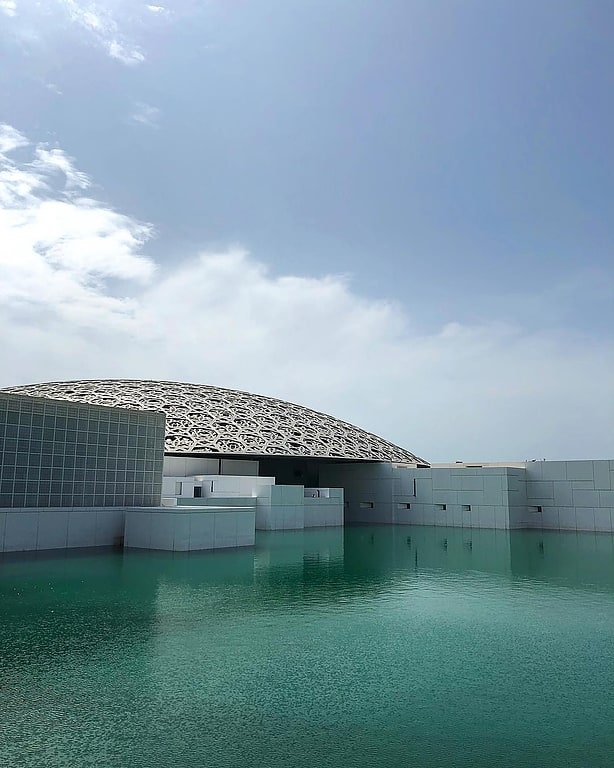
Also known as: اللوفر أبوظبي
Unique museum for international artwork. The Louvre Abu Dhabi is an art museum located on Saadiyat Island in Abu Dhabi, United Arab Emirates. It runs under an agreement between the UAE and France, signed in March 2007, that allows it to use the Louvre's name until 2037, and has been described by the Louvre as "France’s largest cultural project abroad." It is approximately 24,000 square metres in size, with 8,000 square metres of galleries, making it the largest art museum in the Arabian peninsula. Artworks from around the world are showcased at the museum, with stated intent to bridge the gap between Eastern and Western art.
By 2019, the Louvre Abu Dhabi had already attracted 2 million visitors, making it the most visited museum in the Arab world.[49]
Address: Saadiyat Cultural District, Abu Dhabi
Tomb of Hafez, Shiraz
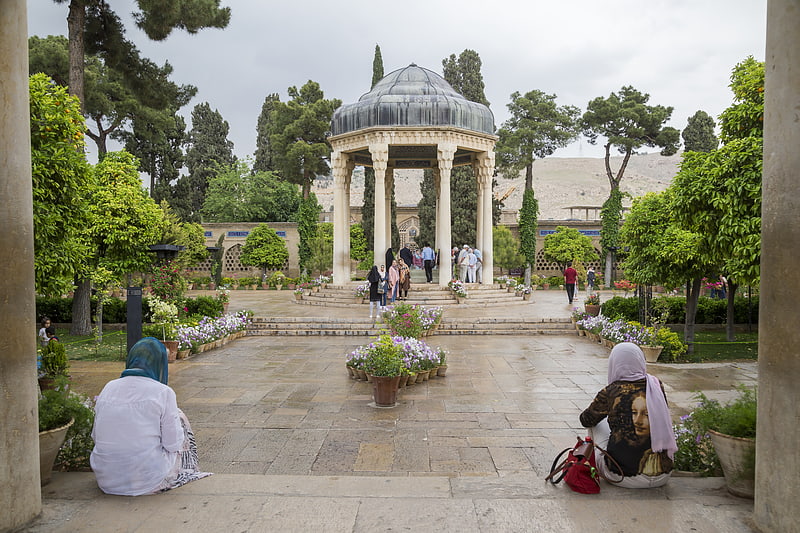
Also known as: حافظیه
Iconic poet's tomb and memorial hall. The Tomb of Hafez, commonly known as Hāfezieh, are two memorial structures erected in the northern edge of Shiraz, Iran, in memory of the celebrated Persian poet Hafez. The open pavilion structures are situated in the Musalla Gardens on the north bank of a seasonal river and house the marble tomb of Hafez. The present buildings, built in 1935 and designed by the French architect and archaeologist André Godard, are at the site of previous structures, the best-known of which was built in 1773. The tomb, its gardens, and the surrounding memorials to other great figures are a focus of tourism in Shiraz.[50]
Address: Hafeziye Street, 71364 Shiraz